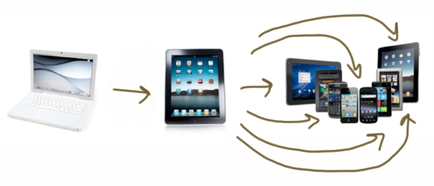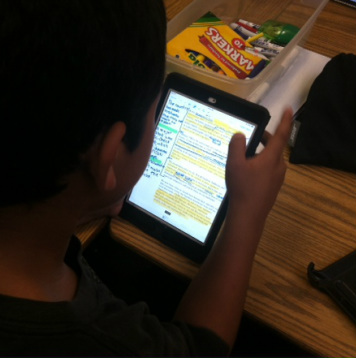|
Teaching in a technology-rich environment is nothing new to me. I've taught a variety of 1:1 and 2:1 programs, and last year my classroom was one of three in PSUSD where students were allowed to BYOD. Our small pilot launched officially in November of last year, and we spent the first two months of school in a 1:1 environment using school site resources (carts of iPads and iPods) to prepare students for the rollout. The program was wildly successful, and this year PSUSD has opened up the Year Two BYOD Pilot to even more classrooms across the district. Awesome! Fast forward to five weeks ago. I was thrilled to send home the BYOD permission form with my parent letter on the first day of school. I couldn't wait for year two of the pilot to begin! As an added challenge, and because I am clearly someone who doesn't shy away from possibly biting off more than they can chew, I decided that this year my BYOD implementation would go from paper lite to paperless as an education experiment of sorts. (To my knowledge, there are currently no other entirely paperless classrooms anywhere else in my district.) Though I toyed with the notion of having kids ask their parents to visit a virtual copy of the letter so I wouldn't have to print any, I ended up biting the bullet and running off copies since 30% of my students do not have Internet access, 88% of them qualify as socio-economically disadvantaged, and some only speak Spanish. I swore that the parent letter would be the ONE copy I'd make all year, and happily punched in my copy code. It was a good decision because BYOD permission forms came rolling in, and starting on the second day of school, kids brought their own devices and started tapping into our school's wifi. Anyone who knows me personally or professionally knows that I am a planner. I am excited by impromptu activities and unafraid to take a rabbit trail during learning, but I definitely give lots of conscientious thought to rolling out technology in my classroom each year. So, why then, did the first month of school seem so much like nightmare stay in Purgatory, sans the elevator music and white waiting room motif I've always imagined? Let me just say this: BYOD teachers live in a constant state of problem-solving, unlike any other 1:1 environment. There were moments during the first month that, if I were a different woman and not PACKwoman, I absolutely would have given in. In retrospect, the really killer aspect of teaching and learning with BYOD is the fact that each set of instructions need to be given several times for several different platforms. During the first days of school, students are trapped in the learning curve - which is HUGE - as they try to become comfortable working in the tech zone. Now, I can reflect and say that starting last year's rollout with a universal platform really helped. Students who have the most difficulty adjusting are those who have little or no previous experience with technology. The term "digital native" is misleading, because students absolutely have to be taught to utilize their devices for educative purposes, which is not something that comes naturally. Knowing how to be entertained with an iPhone is easy, sure. Knowing how to complete assignments, cite information, search effectively, and generate quality content is a whole other skill set.
I think it's important to note that one of the underlying issues in this whole scenario is much more than tech trouble. More than any other year, this particular group of kids seems to lack autonomy. They are 100% the product of high-stakes testing. Getting them to feel comfortable enough to break free, experiment, problem-solve, and think outside the box is going to be the biggest challenge of all. I have no doubt my students will eventually be able to get there; it's just a matter of how much time it will take. This is probably the part where I should affirm, I do have hope! Last week was our fifth week of school, and this much is true: good things come to those who wait. As I looked around the room at the end of the first block of students on Tuesday morning, I was struck by a single thought: "Success." All 39 students had successfully logged in to Google Drive. They had successfully completed a close reading activity in eBackpack, podcasted on AudioBoo, made a mind map in Skitch, and responded to prompts with Socrative. The rest of last week coasted by with only positive results. I am still sighing in relief. Do you have any BYOD or paperless tips? Comment below or hit me up on Twitter to continue the conversation.
0 Comments
Your comment will be posted after it is approved.
Leave a Reply. |
Author: Jessica PackCalifornia Teacher of the Year. CUE Outstanding Educator 2015. DIGICOM Learning Teacher Consultant. 6th Grade Teacher. Passionate about gamification, Minecraft, digital story-telling, and fostering student voices. Download:Archives
June 2020
Categories
All
|




 RSS Feed
RSS Feed